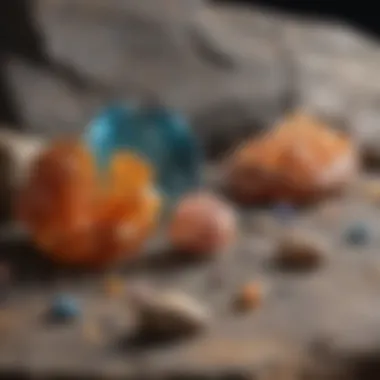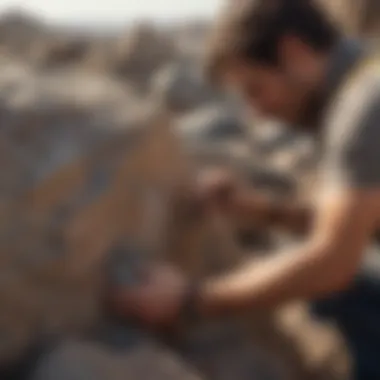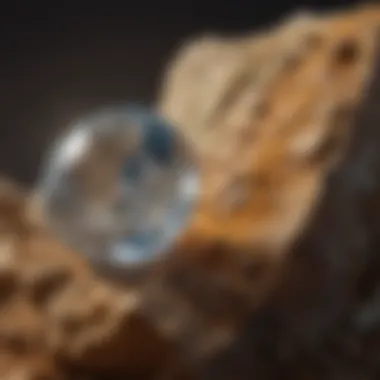Unveiling the Rock Scratch Test: A Comprehensive Guide for Geology Enthusiasts


Rock Identification and Mineral Hardness
In the realm of geology, understanding rock identification and mineral hardness through the rock scratch test is pivotal. By exploring the intricacies of the Mohs scale, geologists can effectively assess the hardness of various minerals, a skill essential for rock classification and mineral analysis. This section will delve into the types of rocks and minerals, presenting the key characteristics to observe when identifying them. Geology enthusiasts will also be introduced to the fundamental tools required for accurate rock and mineral identification.
Practical Techniques for Rock Collecting
Effective rock collecting encompasses more than just a hobby; it is a nuanced practice that requires knowledge and skill. This segment will provide insight into the best practices for collecting rocks and minerals. From locating prime collecting sites with unique geological formations to safely extracting specimens without compromising their integrity, aspiring collectors will gain valuable tips and techniques for enhancing their collecting endeavors.
Preservation Methods and Presentation Ideas
Preserving rock and fossil specimens is paramount to maintaining their integrity and longevity. This module will outline various techniques for preserving rocks and fossils, including proper storage methods to safeguard their physical properties. Moreover, creative display ideas will be explored, offering enthusiasts innovative ways to showcase their collections while preserving the scientific value of each specimen.
Unveiling Geological Marvels and Notable Discoveries
Delve into the captivating world of geological insights, exploring the diverse geological formations and processes that shape our planet's landscape. Unravel the historical significance of rocks and fossils, uncovering the stories embedded within each mineral. Additionally, this section will highlight notable discoveries in the field of geology, showcasing groundbreaking findings that have expanded our understanding of Earth's geological past and present.
Introduction to Rock Scratch Test
The rock scratch test serves as a crucial method for geologists to evaluate mineral hardness accurately. Understanding the nuances of this test is paramount for enthusiasts in the field of geology. In this comprehensive guide, we delve deep into the intricacies of the rock scratch test, shedding light on its significance and practical applications.
Understanding the Importance of Hardness Testing
Defining Hardness in Geology
In the realm of geology, defining hardness is a pivotal aspect that aids in mineral characterization. The ability to determine the resistance of minerals to scratching provides valuable insights into their composition and properties. By exploring the hardness of minerals, geologists can decipher their durability and geological significance, enhancing their overall understanding of rocks and minerals. Understanding the concept of hardness in geology equips geologists with a fundamental tool for mineral identification and classification.
Significance of Mohs Scale
The Mohs scale stands as a cornerstone in the field of mineralogy, offering a standardized method to compare the hardness of different minerals. Its significance lies in providing a relative scale of hardness based on the ability of one mineral to scratch another. By utilizing the Mohs scale, geologists can quickly assess the hardness of unknown minerals through a simple scratch test, enabling efficient mineral identification in the field. Understanding the significance of the Mohs scale empowers geologists to make informed decisions when analyzing rocks and minerals.
Overview of the Mohs Scale


Brief History of Mohs Scale
The history of the Mohs scale traces back to the 19th century when Friedrich Mohs developed this scale as a practical tool for geologists. This scale revolutionized mineral identification by providing a systematic way to measure mineral hardness. Through a series of tests involving ten reference minerals of known hardness, the Mohs scale became widely adopted in the field of geology for its simplicity and effectiveness. Exploring the brief history of the Mohs scale offers insight into the evolution of mineralogical testing and its enduring impact on modern geology.
Key Minerals on the Mohs Scale
Key minerals featured on the Mohs scale, such as talc, gypsum, calcite, and diamond, play a pivotal role in establishing the relative hardness of other minerals. These reference minerals serve as touchstones for geologists to determine the hardness of unknown specimens accurately. By familiarizing themselves with the key minerals on the Mohs scale, geologists can streamline the process of hardness testing and mineral identification in the field. Exploring the key minerals on the Mohs scale enhances geologists' proficiency in assessing mineral hardness with precision.
Tools Required for Rock Scratch Test
Hardness Picks
Hardness picks, composed of various minerals and alloys, are essential tools for conducting the rock scratch test. These picks come in a range of hardness levels, allowing geologists to compare the hardness of minerals through controlled scratching. By utilizing hardness picks, geologists can perform accurate hardness tests in the field and laboratory settings, facilitating precise mineral identification and classification. The versatility and durability of hardness picks make them indispensable instruments for geologists engaged in mineralogical studies.
Protective Equipment
When conducting the rock scratch test, protective equipment such as safety goggles and gloves are vital to ensure the safety of geologists. The abrasive nature of mineral surfaces during scratching poses potential risks to the skin and eyes, making protective gear essential for minimizing injuries. By donning protective equipment, geologists can conduct hardness tests with confidence and security, prioritizing their well-being during fieldwork and laboratory experiments. Incorporating protective equipment into the testing process enhances the overall safety and efficiency of hardness assessments.
Testing Surface
The testing surface serves as a crucial element in the rock scratch test, providing a stable platform for conducting hardness evaluations. A smooth and flat surface is ideal for carrying out scratch tests as it minimizes external variables that could influence the results. Geologists must ensure the cleanliness and uniformity of the testing surface to obtain accurate and reliable hardness measurements. By selecting an appropriate testing surface, geologists can enhance the precision and reproducibility of their hardness tests, leading to more robust mineralogical analyses.
Conducting the Rock Scratch Test
The section on Conducting the Rock Scratch Test delves into a crucial aspect of geology exploration. It is pivotal for geologists and rock enthusiasts alike to comprehend the intricacies of rock hardness evaluation. By conducting the scratch test, individuals can assess the durability and resistance of various minerals, aiding in their identification and classification processes. Understanding the Mohs scale and how it correlates to the scratch test is imperative for accurate assessments and detailed analyses.
Step-by-Step Procedure
Selecting the Test Subject
Selecting the test subject is a critical initial step in the rock scratch test. Geologists must carefully choose a mineral sample of interest, ensuring that it represents the typical hardness range they aim to explore. The chosen subject should exhibit distinct physical properties that allow for clear scratch observation and analysis. Opting for minerals with varying degrees of hardness enables testers to grasp the spectrum of scratch patterns and identify key differences in resistance levels. While selecting the test subject, considering factors such as composition, crystal structure, and previous knowledge about the mineral assists testers in conducting a comprehensive and informative scratch test.
Applying Scratching Pressure


Applying scratching pressure accurately is essential to elicit reliable results in the rock scratch test. Maintaining consistent pressure during the scratching process is vital to generating uniform and discernible scratch marks on the mineral surface. Testers should strike a balance between exerting enough force to cause a noticeable scratch while avoiding excessive pressure that may damage the sample or skew the results. By following a standardized scratching pressure technique, geologists ensure the reproducibility and accuracy of their hardness assessments, facilitating reliable comparisons with established hardness scales.
Observing Scratches
Observing scratches meticulously is a pivotal aspect of the rock scratch test procedure. Testers must attentively inspect the scratch morphology, including length, depth, and appearance, to glean valuable insights into the mineral's hardness properties. Through systematic scratch observation, geologists can identify characteristic patterns that align with specific hardness levels on the Mohs scale, aiding in the mineral classification process. By documenting and cataloging scratch observations accurately, testers build a comprehensive dataset for future reference and comparative analysis.
Advanced Techniques and Considerations
When delving into the intricacies of the rock scratch test, one cannot overlook the crucial role played by advanced techniques and considerations. In this article, we aim to shed light on specific elements that elevate the accuracy and reliability of hardness assessments in geology. By incorporating advanced techniques, enthusiasts and experts can enhance their understanding of mineral hardness and streamline the identification process.
Enhancing Accuracy
Testing Variables
Exploring the realm of testing variables unveils a fundamental aspect of the rock scratch test. By meticulously manipulating variables such as scratching pressure, angle, and speed, geologists can attain precise and consistent results. The key characteristic of testing variables lies in their ability to uncover subtle differences in hardness levels among minerals, enabling practitioners to make nuanced distinctions. This adaptability makes testing variables a popular choice in this article, where precision and reliability are paramount. Despite their benefits, testing variables also come with challenges, including the need for standardized procedures to mitigate subjective influences.
Multiple Scratching Angles
The utilization of multiple scratching angles is a strategic approach to enhancing accuracy in hardness assessments. By varying the angle of applied pressure during the scratch test, geologists can garner comprehensive insights into the hardness profile of a mineral. This technique's unique feature lies in its capacity to reveal different hardness qualities based on directionality, offering a multi-dimensional perspective. While multiple scratching angles contribute significantly to the depth of analysis in this article, they also present challenges in interpretation due to the complexity of determining the primary scratch direction.
Challenges and Limitations
Soft vs. Hard Minerals
The dichotomy between soft and hard minerals poses a compelling challenge in hardness assessments. Distinguishing between these categories is crucial for accurate mineral identification and classification. The key characteristic of this distinction lies in the varying degrees of resistance each mineral offers to scratching, guiding geologists towards informed conclusions. Soft vs. hard minerals bring a rich layer of complexity to the rock scratch test, offering opportunities for detailed exploration while necessitating careful consideration of factors influencing hardness perception.
Surface Texture Interference
Navigating the realm of surface texture interference reveals a lesser-known but significant limitation in hardness assessments. The interplay between a mineral's surface texture and its inherent hardness properties can confound scratch test results, leading to erroneous interpretations. The unique feature of surface texture interference is its capability to mask the true hardness level of a mineral, posing a challenge for accurate assessments. While acknowledging this limitation is essential in our exploration, geologists must develop strategies to minimize the impact of surface texture variations on hardness evaluations.
Digital Tools for Hardness Assessment
Digital Microscopy


Integrating digital microscopy into the realm of hardness assessment revolutionizes the way geologists examine geological specimens. By magnifying mineral surfaces with precision and clarity, digital microscopy offers insights into microscopic hardness features that enhance traditional scratch testing. The key characteristic of digital microscopy is its ability to capture detailed images for comprehensive analysis, making it a valuable asset in this article focused on accuracy and detail. However, the reliance on digital tools introduces the risk of overlooking macroscopic hardness cues.
Hardness Testing Apps
Hardness testing apps represent a modern solution to traditional hardness assessment methods, providing geologists with convenient and portable tools for on-the-go analysis. The key characteristic of hardness testing apps lies in their user-friendly interfaces and accessibility, catering to a tech-savvy audience seeking efficient mineral identification solutions. Despite their advantages, such apps may face limitations in capturing nuanced hardness variations compared to in-person scratch tests. Geologists must balance the convenience of digital applications with the need for comprehensive hardness evaluations in their mineral studies.
Practical Tips for Rock and Mineral Collectors
Delving into the world of rock and mineral exploration requires more than just enthusiasm; it demands a systematic approach embedded with practical tips to ensure a fruitful journey. In this article, we unravel the essence of Practical Tips for Rock and Mineral Collectors, shedding light on crucial elements that can elevate your collecting experience to new heights.
Building a Scratch Test Kit
Essential Tools
Embarking on the journey of mineral exploration necessitates equipping oneself with essential tools tailored to intricacies ingrained in the field. The Essential Tools segment within the Scratch Test Kit blueprint provides a foundation indispensable for accurate assessments. The magnifying glass stands out as a pivotal element within the gamut of tools, facilitating detailed inspections to discern subtle mineral characteristics with precision. Its optical prowess unveils a realm of details elusive to the naked eye, making it a cornerstone in the world of mineral collection. However, despite its optical marvels, maintaining a clean lens devoid of smudges ranks among its challenges, requiring diligent care for optimal performance amidst field conditions.
Organizational Tips
Organization intertwines with efficiency, especially in the realm of mineral collection where meticulous categorization cultivates a cohesive workflow. Organizational Tips encapsulate the art of structuring your collection space, ensuring seamless accessibility to your array of minerals. Implementing a labeling system emerges as the bedrock of organizational prowess, enabling swift identification and retrieval of specimens in your collection repertoire. This systematic approach not only streamlines your collection process but also fosters a deeper understanding of mineral profiles through categorization, enhancing your overall collecting experience. Despite its efficacy, maintaining consistency in labeling poses a perpetual challenge, warranting continuous vigilance to uphold organizational efficiency across your mineral trove.
Safe Handling of Minerals
Avoiding Contamination
Navigating the intricate landscape of mineral handling mandates vigilant measures to avert contamination risks intricately intertwined with the collection process. Avoiding Contamination emerges as a beacon of caution, steering collectors away from inadvertent pollution of their mineral specimens. The use of clean gloves emerges as a prime deterrent against external pollutants, safeguarding the pristine integrity of specimens against unintended contamination. However, despite their protective shield, erratic changes in weather conditions pose a perpetual threat, necessitating conscientious attention to environmental dynamics to mitigate contamination risks effectively.
Proper Storage
Preservation lies at the heart of mineral collection longevity, catapulting proper storage mechanisms to the forefront of collector considerations. Proper Storage guidelines furnish collectors with insights into securing their prized specimens against physical degradation and environmental incursions. Utilizing airtight containers emerges as a sanctuary for mineral preservation, shielding specimens against atmospheric erosions that could mar their pristine allure. Despite their protective cocoon, container labeling emerges as a pressing concern, requiring legible markings to circumvent misidentifications and uphold storage integrity amidst a repository of geological wonders.
Exploration and Documentation
Field Testing Techniques
Exploration embodies the quintessence of mineral collection, beckoning collectors to unearth hidden geological treasures buried beneath the earth's crust. Field Testing Techniques intricately weave together methodical approaches essential for on-site mineral assessments. The streak plate serves as a compelling ally in discerning distinctive mineral streaks, unraveling a spectrum of hues that unveil mineral identities shrouded in geological enigma. However, despite its diagnostic capabilities, the fragility of streak plates poses a vulnerability, necessitating cautious handling to avert inadvertent damages that could impede accurate mineral evaluations.
Recording Observations
Documentation immortalizes the essence of mineral exploration, etching a narrative of geological encounters that stand the test of time. Recording Observations not only memorializes mineral findings but also scaffolds a comprehensive understanding of geological landscapes traversed. Maintaining a detailed journal emerges as a foundational pillar in the edifice of mineral documenting, capturing intricate details that enrich future explorations and deepen geological insights. Yet, despite its archival prowess, maintaining consistent journal entries emerges as a perpetual challenge, demanding unwavering dedication to articulate compelling narratives amidst the transient flux of geological revelations.







